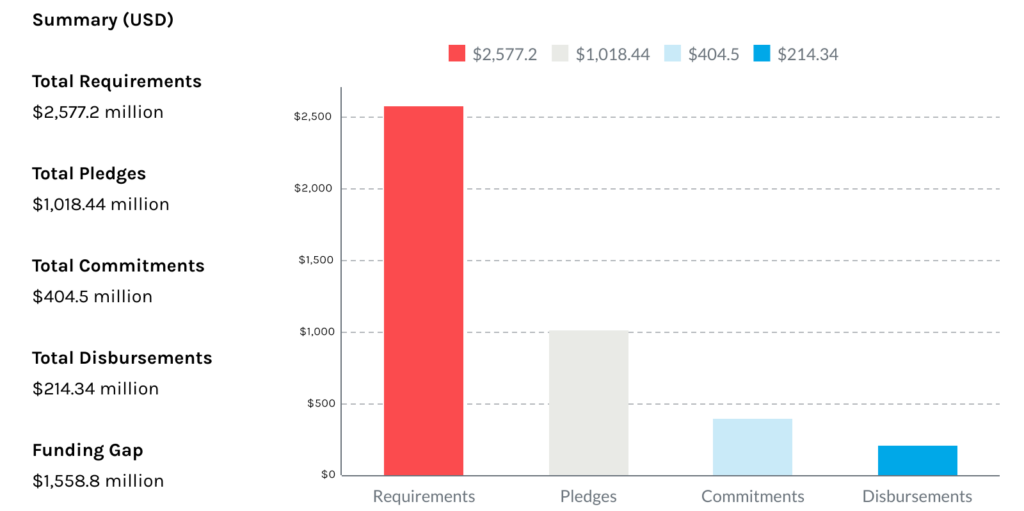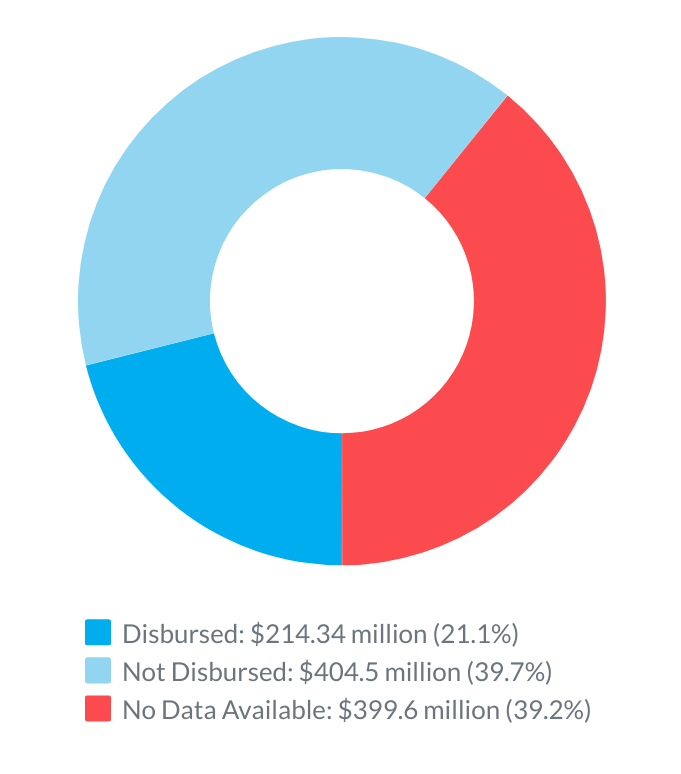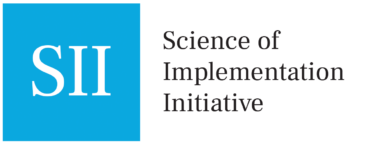Ebola in Guinea
As of March 2016, Guinea reported 3,811 cases of Ebola and 2,543 fatalities. Though at the time these were the lowest figures among the three heavily-affected countries, the fatality rate in Guinea was the highest, with approximately 66.7 percent of patients succumbing to the disease compared to 45 percent in Liberia and 28 percent in Sierra Leone.1
Pledges, Commitments, and Disbursements from Contributions Announced at the July 2015 International Ebola Recovery Conference (USD Millions)

Disbursements as Percentage of $1,018 Million Pledged
(Based on information received from donors)

The following text has been excerpted from The Government of Guinea Post-Ebola Socio-Economic Recovery Strategy (2015-2017)
The health impact is compounded by the fear around Ebola, which has led people to reject proper health practices: a 20 percent decline in use of health facilities for assisted births; a 25 percent decline in prenatal consultations by 25 percent; and, the closing of 94 health centres and district hospitals in December 2014. Vaccination coverage has also decreased by 30 percent. To secure children’s lives and those of the general population, the Government had to delay the opening of 2014-2015 school year by four months. The country experienced a drop in school attendance (around 35 percent), especially in areas severely affected by the disease, where the number of daily meals had been reduced to 74 percent of households during the crisis.7
The disease also had a violent impact in economic and financial terms. The real economic growth rate declined significantly to 1.1 percent in 2014, against a forecast of 4.5 percent, while for 2015, the projected growth is zero. The tax revenue shortfalls caused by these reductions are estimated at over 1,150 billion Guinean Franc (approximately US$160 million) while expenses are increasing due to the demands for health care needs in the prevention and treatment of the disease. As a result, the public deficit has deepened and funding needs of the State increased, including in the form of budget support. Many jobs were lost: according to official statistics, six (6) redundancy plans were announced and 2,180 job losses were recorded in the formal sector at the end of February 2015.8
Overall, the Ebola crisis severely affected all sectors of the Guinean economy: Livelihoods were undermined, food security threatened, incomes of Guinean farmers compromised, employment opportunities and means of urban and rural incomes diminished while foreign investment declined.
Based on the issues and challenges posed by Ebola and development goals of its Poverty Reduction Strategy Paper, 2013-2015, the Government has developed its strategy to allow Guinea to recover from the consequences of the crisis, rebuild its economic and social development, and resilience. This strategy has resulted in a Post-Ebola Priority Action Plan (PAPP) built around programmes and investment projects, and relevant support measures for recovery and resilience.9
The following orientations and priorities have been set in the social domain:
- Upgrading and developing the health system (structures, human resources, drugs, etc.) to meet both immediate needs as well as challenges related to Ebola-like pandemics;
- Providing universal access to water, sanitation and hygiene (WASH) for schools and health facilities, improvement and strengthening of the general access to WASH in the country, particularly for vulnerable people;
- Accelerating the spread of literacy for better resilience;
- Strengthening the advancement of women and the gender approach; and
- Improving child protection.10
Similarly, priorities for the economic domain are:
- Improving the business environment;
- Increasing production systems;
- Recovering and accelerating the diversification of economic activities;
- Renewing support for agricultural intensification;
- Recovery investment in economic infrastructure;
- Revitalizing import and export trade circuits;
- Supporting the processing and storage of agricultural products; and
Revitalizing and rationalizing advisory support, the organization of producers, and research.11
Finally, at a cross-cutting level, state governance will be consolidated and reinforced through reforms to bolster the quality and transparency in public services.
Financial Requirements of the Government of Guinea’s Post Ebola Socio-Economic Recovery Strategy (2015-2017)12
| Program Area | Recovery Cost (USD MILLIONS) | |||
| 2015 | 2016 | 2017 | TOTAL | |
| Health, Nutrition and Water, Sanitation, and Hygiene for All | ||||
| Health | $466.64 | $408.97 | $363.50 | $1,239.11 |
| Hydraulics | $2.54 | $254.58 | $131.58 | $388.71 |
| Governance, Peace Consolidation and Social Cohesion | ||||
| Civil service | $2.72 | $2.72 | $1.69 | $7.14 |
| Land administration | $22.27 | $22.15 | $18.56 | $62.98 |
| Civil protection | $0.44 | $0.13 | $0.00 | $0.57 |
| Communications | $0.41 | $0.04 | $0.04 | $0.49 |
| Public finance | $30.50 | $11.86 | $0.00 | $42.37 |
| Education, Social and Child Protection, and Basic Services | ||||
| Education | $43.38 | $72.13 | $39.97 | $155.48 |
| Social action | $55.62 | $36.71 | $32.16 | $124.49 |
| Socio-Economic Revitalization | ||||
| Agriculture | $43.23 | $50.06 | $58.28 | $151.56 |
| Livestock farming | $3.86 | $2.10 | $6.91 | $12.87 |
| Fisheries | $1.54 | $4.91 | $5.05 | $11.49 |
| Trade | $15.28 | $11.29 | $6.49 | $33.07 |
| Industry | $85.10 | $42.37 | $0.00 | $127.47 |
| Transportation | $0.00 | $1.82 | $2.42 | $4.24 |
| The environment | $1.37 | $0.85 | $0.48 | $2.70 |
| Information and communications technology | $0.00 | $28.81 | $14.41 | $43.22 |
| Public works | $0.00 | $84.74 | $84.55 | $169.29 |
| Total | $774.90 | $1,036.24 | $766.09 | $2,577.23 |
The narrative above includes excerpts from the Government of Guinea’s Post Ebola Socio-Economic Recovery Strategy (2015-2017) . The data regarding donor pledges, commitments and disbursements was collected by the United Nations Office of the Secretary-General’s Special Adviser on Community-Based Health and Aid Delivery.
Footnotes >
- World Health Organization. “Ebola Situation Report.” Updated March 2016.
- Requirements are the resources that were requested in the national and regional recovery plans presented at the United Nations International Ebola Recovery Conference in New York (July 2015.)
- A pledge is a general promise to provide assistance and is usually made for a particular time frame, though not always.
- Committed (or obligated) funds are those for which projects have been approved or agreements/contracts have been signed or are in the process of being transferred or disbursed. Committed funds are exclusive of disbursed funds.
- Disbursement is the transfer of funds from a donor to implementing partners (which could be governments, non-governmental organizations, UN entities, or private contractors, among others).
- The United Nations Office of the Special Adviser on Community Based Medicine and Lessons from Haiti has requested information regarding disbursements from all donors, and will publish any remaining data as soon as it becomes available.
- The Government of Guinea. The Government of Guinea’s Post Ebola Socio-Economic Recovery Strategy (2015-2017). June 2015. p. 7.
- The Government of Guinea. The Government of Guinea’s Post Ebola Socio-Economic Recovery Strategy (2015-2017). June 2015. p. 7.
- The Government of Guinea. The Government of Guinea’s Post Ebola Socio-Economic Recovery Strategy (2015-2017). June 2015. p. 8.
- The Government of Guinea. The Government of Guinea’s Post Ebola Socio-Economic Recovery Strategy (2015-2017). June 2015. p. 8.
- The Government of Guinea. The Government of Guinea’s Post Ebola Socio-Economic Recovery Strategy (2015-2017). June 2015. p. 8.
- The Government of Guinea. The Government of Guinea’s Post Ebola Socio-Economic Recovery Strategy (2015-2017). June 2015. p. 78.
